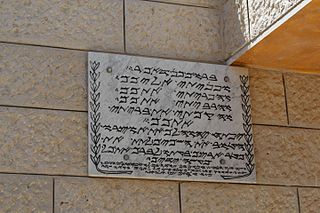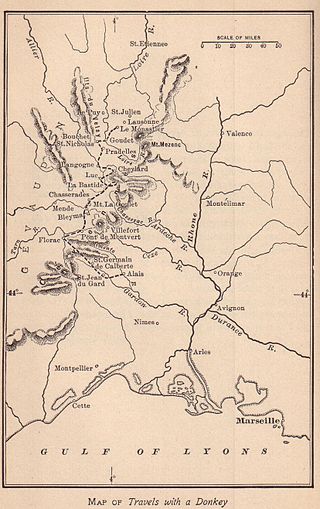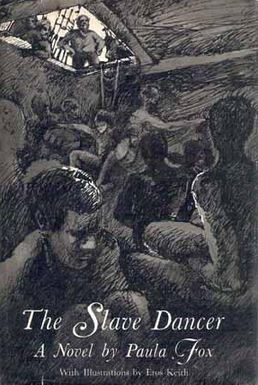
Samaritanism is an Abrahamic monotheistic ethnic religion. It comprises the collective spiritual, cultural, and legal traditions of the Samaritan people, who originate from the Hebrews and Israelites and began to emerge as a relatively distinct group after the Kingdom of Israel was conquered by the Neo-Assyrian Empire during the Iron Age. Central to the faith is the Samaritan Pentateuch, which Samaritans believe is the original and unchanged version of the Torah.

Gary Cooper was an American actor known for his strong, quiet screen persona and understated acting style. He won the Academy Award for Best Actor twice and had a further three nominations, as well as an Academy Honorary Award in 1961 for his career achievements. He was one of the top-10 film personalities for 23 consecutive years and one of the top money-making stars for 18 years. The American Film Institute (AFI) ranked Cooper at number 11 on its list of the 25 greatest male stars of classic Hollywood cinema.

The Stranger, also published in English as The Outsider, is a 1942 novella written by French author Albert Camus. The first of Camus's novels published in his lifetime, the story follows Meursault, an indifferent settler in French Algeria, who, weeks after his mother's funeral, kills an unnamed Arab man in Algiers. The story is divided into two parts, presenting Meursault's first-person narrative before and after the killing.
Samaritans is a registered charity aimed at providing emotional support to anyone in emotional distress, struggling to cope or at risk of suicide throughout the United Kingdom and the Republic of Ireland, often through its telephone helpline. Its name derives from the biblical Parable of the Good Samaritan, although the organisation itself is not religious.
Earl V. Shaffer, was an American outdoorsman and author known from 1948 as The Crazy One for attempting what became the first publicized claimed hiking trip in a single season over the entire length of the Appalachian Trail (AT). He also worked as a carpenter, a soldier specializing in radar and radio installation, and an antique dealer.

Edward Chad Varah was a British Anglican priest and social activist from England. In 1953, he founded the Samaritans, the world's first crisis hotline, to provide telephone support to those contemplating suicide.

Paul Belloni Du Chaillu was a French-American traveler, zoologist, and anthropologist. He became famous in the 1860s as the first modern European outsider to confirm the existence of gorillas, and later the Pygmy people of central Africa. He later researched the prehistory of Scandinavia.

Outdoor literature is a literature genre about or involving the outdoors. Outdoor literature encompasses several different subgenres including exploration literature, adventure literature, mountain literature and nature writing. Another subgenre is the guide book, an early example of which was Thomas West's guide to the Lake District published in 1778. The genres can include activities such as exploration, survival, sailing, hiking, mountaineering, whitewater boating, geocaching or kayaking, or writing about nature and the environment. Travel literature is similar to outdoor literature but differs in that it does not always deal with the out-of-doors, but there is a considerable overlap between these genres, in particular with regard to long journeys.

John 4 is the fourth chapter of the Gospel of John in the New Testament of the Christian Bible. The major part of this chapter recalls Jesus' interaction with the Samaritan woman at the well in Sychar. In verses 43-54, he returns to Galilee, where he heals a royal official's son.

The Slave Dancer is a historical novel written by Paula Fox and published in 1973. It tells the story of a boy called Jessie Bollier who witnessed first-hand the savagery of the Atlantic slave trade. The book not only includes a historical account, but it also touches upon the emotional conflicts felt by those involved in transporting the slaves from Africa to other parts of the world. It tells the story of a thirteen-year-old boy, Jessie Bollier, who is put in a position which allows him to see the African slave trade in person. Jessie is captured from his New Orleans home and brought to an American ship. There he is forced to play the fife in order to keep the other slaves dancing, and thus strong when they arrive at their destination. The book received the Newbery Medal in 1974.
Peter Jenkins is an American travel author known for walking from New York to Oregon between October 1973 and January 1979 while writing a bestselling book, A Walk Across America.

Sarat Chandra Dash was an Indian scholar of Tibetan language and culture most noted for his two journeys to Tibet in 1879 and in 1881–1882.

Walk on the Wild Side is a 1962 American drama film directed by Edward Dmytryk, and starring Laurence Harvey, Capucine, Jane Fonda, Anne Baxter and Barbara Stanwyck. It was adapted from the 1956 novel A Walk on the Wild Side by American author Nelson Algren. The film was scripted by John Fante.

The Outsider is the name of three different characters appearing in American comic books published by DC Comics.
Wallace Andrew Hebert was a sidearming left-handed Major League Baseball starting pitcher who played from 1931 to 1933 for the St. Louis Browns and in 1943 for the Pittsburgh Pirates. His professional career began in 1930.

Mahaprasthanika Parva, or the "Book of the Great Journey", is the seventeenth of eighteen books of the Indian epic Mahabharata. It traditionally has three chapters, as does the critical edition. It is the shortest book in the epic.
Leon McCarron is a Northern Irish adventurer, filmmaker and author. He is a Fellow of the Royal Geographical Society, and specialises in storytelling via long distance, human-powered journeys. Most recently, he walked 1000 miles from Jerusalem to Mount Sinai along a series of new hiking trails in the region.

The 1891 New Orleans lynchings were the murders of 11 Italian Americans, immigrants in New Orleans, by a mob for their alleged role in the murder of police chief David Hennessy after some of them had been acquitted at trial. It was the largest single mass lynching in American history. Most of the lynching victims accused in the murder had been rounded up and charged due to their Italian ethnicity.

Ishi in Two Worlds is a biographical account of Ishi, the last known member of the Yahi Native American people. Written by American author Theodora Kroeber, it was first published in 1961. Ishi had been found alone and starving outside Oroville, California, in 1911. He was befriended by the anthropologists Alfred Louis Kroeber and Thomas Waterman, who took him to the Museum of Anthropology in San Francisco. There, he was studied by the anthropologists, before his death in 1916. Theodora Kroeber married Alfred Kroeber in 1926. Though she had never met Ishi, she decided to write a biography of him because her husband did not feel able to do so.














